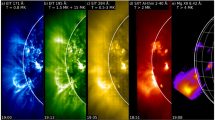Summary
Recently γ-rays up to 1016 eV were observed from Cyg X3, Vela X1 and LMC X4. This is a strong indication that protons (or nuclei) are accelerated in the vicinity of the accreting pulsar. We discuss in this paper the production of high-energy neutrinos associated with the γ-ray production. We show that on the basis of observational parameters of the three binary systems, the time average of the ratio of the neutrino luminosity to the γ-ray luninosity will beL ν/Lγ∼30. The neutrino flux will be modulated with the orbital period of the system and the neutrino light curve will be determined by the density profile of the companion star. In general some of the X-ray binaries can be both UHE γ-ray and neutrino emitters with a neutrino luminosity comparable to their X-ray luminosity. The brightest of these could be detected by future neutrino telescopes such as DUMAND and MACRO at Gran Sasso.
Riassunto
Recentemente è stata rivelata emissione di raggi gamma con energia sino a 1016eV da Cyg X3, Vela X1 ed LMC X4. Questa osservazione indica che protoni (o nuclei) sono accelerati nella vicinanza della pulsar contenuta in questi tre sistemi binari. In questo lavoro si calcola la produzione di neutrini di alta energia, associata alla produzione di raggi gamma. Il risultato ottenuto è che, tenendo conto dei parametri dedotti dalle osservazioni spettroscopiche dei tre sistemi considerati, il rapporto tra la luminosità in neutrini e la luminosità gamma èL ν/Lγ∼30. Inoltre il flusso di neutrini sarà modulato con il periodo binario del sistema e la curva di luce dei neutrini sarà determinata dalla distribuzione di densità della stella compagna. In generale alcune delle binarie X possono essere sorgenti sia di gamma di altissima energia che di neutrini, con una luminosità in neutrini paragonabile alla luminosità in raggi X. Le piú intense tra queste potranno essere osservate da futuri telescopi per neutrini come DUMAND o MACRO.
Резюме
Недавно γ-кванты с энергиями вплоть до 1016 эВ наблюдались из Cyg X3, Vela X1 и LMC X4. Это является указанием, что протоны (или ядра) ускоряются в окрестности аккретирующего пульсара. Мы обсуждаем в этой статье образование высокоэнергетичных нейтрино, которые связано с рождением γ-квантов. Мы показываем, что на основе наблюденных параметров для трех бинарных сйстем среднее по времени отношение интенсивности испускания нейтрино к интенсивности испускания γ-квантов составляетL ν/Lμ∼30. Модуляция потока нейтрино определяется орбитальным периодом системы, а кривая яркости нейтрино определяется профилем плотности сопутствующей звезды. Обычно ренттеновские бинарные системы могут представлять источники γ-квантов сверхвысоких энергий и источники нейтрино, причем интенсивность испускания нейтрино сопоставима с интенсивностью рентгеновского излучения. Наиболее яркие из них могут быть зарегистрированы в будущем с помощью нейтринных телескопов, таких как DUMAND и MACRO в Гран Сассо.
Similar content being viewed by others
References
R. Giacconi, H. Gursky, E. Kellog, E. Schreier andH. Tananbaum:Astrophys. J. Lett.,167, L67 (1971).
H. Tananbaum, H. Gursky, E. M. Kellog, R. Levinson, E. Schreier andR. Giacconi:Astrophys. J. Lett.,174, L143 (1972).
K. Davidson andJ. P. Ostriker:Astrophys. J.,179, 585 (1973).
S. Rappaport andP. C. Joss:Nature (London),266, 683 (1977).
M. M. Basko andP. Sunyaev:Sov. Astron. AJ. (Engl. Transl.),26, 537 (1976).
M. Samorsky andW. Stamm:Astrophys. J. Lett.,268, L17 (1983).
J. Lloyd-Evans, R. N. Coy, A. Lambert, J. Lapikens, M. Patel, R. J. O. Reid andA. A. Wilson:Nature (London),305, 784 (1983).
R. J. Protheroe, R. W. Clay andP. R. Gerhardy:Astrophys. J. Lett.,280, L47 (1984).
R. J. Protheroe andR. W. Clay:Nature (London),315, 205 (1985).
G. F. Bignami andW. Hermses:Annu. Rev. Astron. Astrophys.,21, 67 (1983).
R. C. Lamb, C. E. Fichtel, R. C. Hartman, D. A. Kniffen andD. J. Thomson:Astrophys. J. Lett.,212, L63 (1977).
J. Wdowczyk andA. W. Wolfendale:Nature (London),305, 609 (1983).
M. L. Marshak, J. Bartelt, H. Courant, K. Heller, T. Joyce, E. A. Peterson, K. Ruddick, M. Shupe, D. S. Ayres, J. Dawson, T. Fields, E. N. May, L. E. Price andK. Sivaprasad:Phys. Rev. Lett.,54, 2079 (1985).
G. Battistoni, E. Bellotti, C. Bloise, G. Bologna, P. Campana, C. Castagnoli, A. Castellina, V. Chiarella, A. Ciocio, D. Cundy, B. D'Ettorre-Piazzoli, E. Fiorini, P. Galeotti, E. Iarocci, C. Liguori, G. Mannocchi, G. Murtas, P. Negri, G. Nicoletti, P. Picchi, M. Price, A. Pullia, S. Ragazzi, M. Rollier, O. Saavedra, L. Satta, P. Serri, S. Vernetto andL. Zanotti:Phys. Lett. B, to be published.
M. V. Barnhill III, T. K. Gaisser, T. Stanev andF. Halzen: preprint MAD-PH-243 (April 1985).
W. T. Vestrand andD. Eichler:Astrophys. J.,261, 251 (1982).
A. M. Hillas:Nature (London),312, 50 (1984).
D. Eichler andW. T. Vestrand:Nature (London),307, 613 (1984).
G. Chanmugam andK. Brecher:Nature (London),313, 767 (1985).
V. S. Beretzinsky andV. V. Volinsky:Proceedings of the XVI International Cosmic Ray Conference, MN 6-5 (Kyoto, 1979), p. 326.
V. J. Stenger:Astrophys. J.,284, 810 (1984).
H. Lee andS. A. Bludman:Astrophys. J.,290, 28 (1985).
T. K. Gaisser andT. Stanev:Phys. Rev. Lett.,54, 2265 (1985).
A. Dar:Phys. Rev. Lett.,51, 227, (1983).
D. D. Clayton:Principles of Stellar Evolution and Nucleosynthesis (McGraw-Hill, New York, N. Y., 1968).
H. V. D. Bradt andJ. E. McClintock:Annu. Rev. Astron. Astrophys.,21, 13 (1983).
Very similar results are obtained byF. W. Stecker, A. K. Harding andJ. J. Barnard: preprint GSFC (1985).
V. J. Stenger: preprint HDC-4-85 (April 1985).
T. K. Gaisser andT. Stanev:Phys. Rev. D,31, 2770 (1985).
Author information
Authors and Affiliations
Rights and permissions
About this article
Cite this article
Auriemma, G., Bilokon, H. & Grillo, A.F. High-energy neutrino emission from binary X-ray sources. Il Nuovo Cimento C 9, 451–458 (1986). https://doi.org/10.1007/BF02514863
Received:
Issue Date:
DOI: https://doi.org/10.1007/BF02514863




